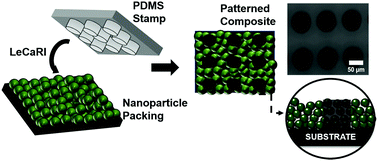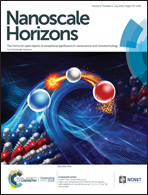Patterning polymer-filled nanoparticle films via leaching-enabled capillary rise infiltration (LeCaRI)†
Abstract
Polymer-infiltrated nanoparticle films (PINFs) are a class of nanocomposites with unusual and synergistic physical properties due to the extremely high loadings (well above 50 vol%) of nanoparticles (NP). Thermal and solvent-based routes have been utilized to induce polymer infiltration into the interstitial pores of NP packings to make PINFs. Patterning these highly filled PINFs could be extremely useful for applications that require lateral modulation of properties. In this work, we take advantage of leaching of mobile, uncrosslinked species from an elastomer network to enable rapid patterning of PINFs at room temperature without use of any solvents. When a NP film is brought into contact with an elastomer network, uncross-linked chains are leached out of the elastomer into the pores of the NP packing by capillarity. The extent of infiltration can be controlled by varying the particle size and the humidity. By using elastomers with surface features, infiltration of mobile species can be localized to pattern PINFs. The mobile species in the patterned regions spread laterally over time making it possible to generate laterally graded compositions. Alternatively, the patterns can also be fixed in space using oligomers that can be crosslinked upon UV exposure. LeCaRI holds great potential as a general approach to the scalable manufacturing of patterned polymer nanocomposite films for applications that require lateral modulation of optical, mechanical and wetting properties.



 Please wait while we load your content...
Please wait while we load your content...